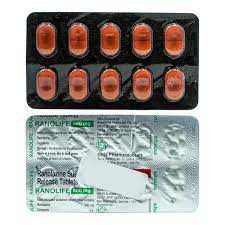
ranolife (RANOLAZINE)

What is Ranolife?
Ranolife is primarily used to treat chronic angina (chest pain) in patients with heart disease. It works by improving blood flow to the heart muscle, reducing the strain on the heart, and helping it function more efficiently. Ranolife does this by inhibiting certain sodium and calcium channels in heart cells, which helps reduce heart cell stress and improves oxygen use, thereby reducing angina symptoms.

What is the usual dose of Ranolife?
For adults, the usual dose of Ranolife for chronic angina is:
- Initial Dose: 500 mg taken orally twice daily.
- Titration: May increase to 1000 mg taken orally twice daily based on clinical response.
- Maximum Dose: 1000 mg twice daily.
For children, the use of Ranolife has not been established, and dosing should be determined by a healthcare provider.

How do I take Ranolife?
Ranolife can be taken with or without food. There are no specific food restrictions while taking this medication. However, it should be swallowed whole, and the tablets should not be crushed or chewed. If you are taking other medications or have any concerns, consult your doctor to avoid any potential interactions or issues. Always follow your healthcare provider’s specific instructions regarding dosage and administration.

For how long do I take Ranolife?
The typical duration of Ranolife use for chronic angina is generally long-term, as it is intended for ongoing management rather than a short-term treatment. Clinical trials have administered Ranolife for up to 12 weeks, but many patients may continue using it for months or years under a healthcare provider's supervision to maintain control over their symptoms. Regular follow-ups are essential to assess efficacy and adjust dosing as needed.

What is Ranolife used for?
Ranolife is primarily indicated for the treatment of chronic angina (chest pain) in patients with stable coronary artery disease. It helps to manage angina symptoms by improving blood flow to the heart and reducing the heart's oxygen demand. Ranolife may be used in combination with other medications to control symptoms of angina and improve overall heart function.

How long does it take for Ranolife to start working?
Ranolife typically starts to show its effects in 1 to 2 weeks, with some patients experiencing noticeable improvements in their angina symptoms, such as reduced chest pain or improved exercise tolerance. However, the full therapeutic benefit may take up to 4 weeks to become evident. It’s important to continue taking the medication as prescribed and follow up with your doctor to monitor progress.

Is Ranolife effective?
Clinical studies have shown that Ranolife is effective in reducing angina symptoms and improving exercise tolerance in patients with chronic angina. Trials demonstrated that Ranolife can significantly reduce the frequency of chest pain episodes and improve the overall quality of life without causing major side effects. It has also been shown to be beneficial when used in combination with other angina medications, providing enhanced symptom control and reducing the need for additional treatments.

How does one know if Ranolife is working?
The benefit of Ranolife is evaluated by monitoring improvements in angina symptoms, such as reduced chest pain, increased exercise tolerance, and better overall quality of life. Doctors may use exercise stress tests or patient-reported outcomes to assess the medication’s effectiveness. Regular follow-up appointments allow healthcare providers to track symptom changes and adjust treatment if needed.

How does Ranolife work?
Ranolife works by inhibiting certain sodium and calcium channels in the heart cells. This reduces the sodium overload in the heart muscle, helping to prevent an increase in intracellular calcium levels, which in turn reduces the heart's oxygen demand. By improving the heart's efficiency in using oxygen, Ranolife helps to reduce symptoms of angina (chest pain) and improve exercise tolerance, without significantly affecting heart rate or blood pressure.

Who should avoid taking Ranolife?
Ranolife should be used with caution in patients with liver disease, as it may affect liver function. It is contraindicated in patients with pre-existing QT prolongation or those who are taking medications that significantly affect the QT interval, such as certain antiarrhythmic drugs. It should also be avoided in patients with severe kidney impairment. Additionally, Ranolife can interact with other drugs that affect CYP3A enzymes and should be used with caution when combined with drugs like antifungals or antibiotics. Always consult a healthcare provider before starting or combining treatments.

Can I take Ranolife with vitamins or supplements?
Ranolife has minimal interactions with vitamins or supplements. However, it may interact with supplements that affect CYP3A enzymes, such as grapefruit or grapefruit juice, which can increase Ranolife levels in the blood, raising the risk of side effects. While St. John’s Wort may reduce the effectiveness of Ranolife by affecting liver enzymes, most vitamins and mineral supplements do not pose significant interactions. Always consult a healthcare provider before adding new supplements.

Can I take Ranolife with other prescription drugs?
Ranolife has several significant prescription drug interactions:
- CYP3A inhibitors (e.g., ketoconazole, clarithromycin) can increase Ranolife levels, increasing the risk of side effects such as QT prolongation.
- CYP3A inducers (e.g., rifampin, St. John’s Wort) can lower Ranolife levels, reducing its effectiveness.
- Antiarrhythmic drugs like amiodarone or dofetilide can increase the risk of QT prolongation when taken with Ranolife.
- Grapefruit and grapefruit juice should be avoided as they can increase Ranolife blood levels.

Can Ranolife be taken safely while pregnant?
Ranolife is classified as a Category C drug during pregnancy, meaning that animal studies have shown potential risks to the fetus, but human studies are limited. While there is no conclusive evidence of harm, it should only be used during pregnancy if the potential benefits outweigh the risks. Pregnant women should consult their doctor before using Ranolife, especially if they are at risk for heart disease or angina.

Can Ranolife be taken safely while breastfeeding?
Ranolife is excreted in breast milk in small amounts, but there is limited data on its safety during lactation. Due to the potential for adverse effects on a breastfeeding infant, it's recommended to either avoid breastfeeding while using Ranolife or discontinue the medication if the infant is nursing. Mothers should consult their healthcare provider to weigh the risks and benefits of using Ranolife while breastfeeding.

Is Ranolife safe for the elderly?
When prescribing Ranolife to elderly patients, consider the following recommendations and warnings for safe use:
- Cautious Dose Titration: Start at the lowest effective dose due to increased sensitivity and potential for adverse effects, particularly in those over 75 years old.
- Increased Adverse Events: Elderly patients may experience a higher incidence of side effects, including constipation, nausea, hypotension, and vomiting.
- Monitor Renal Function: Regularly assess renal function, as age-related decline may increase Ranolife exposure and risk of adverse effects.
- Drug Interactions: Be cautious of potential interactions with other medications, especially CYP3A4 inhibitors.

How should I store Ranolife?
Ranolife should be stored at room temperature (20°C to 25°C or 68°F to 77°F) in a tightly closed container. Keep it away from moisture, heat, and direct sunlight. Do not store it in the bathroom or places with high humidity. Keep the medication out of reach of children, and dispose of expired or unused tablets properly. Always check the expiration date before use.

Does Ranolife make people tired or drowsy?
Ranolife does not commonly cause tiredness or drowsiness. If you feel unusually fatigued, consult your doctor, as it may indicate other issues.

Does Ranolife cause stomach upset?
Ranolife may cause nausea, constipation, or vomiting in some users, but these side effects occur in less than 10% of people. Staying hydrated and eating light meals may help; consult your doctor if symptoms persist.

Does Ranolife affect sleep?
Sleep disturbances are rare with Ranolife. If you experience issues such as insomnia, discuss them with your healthcare provider.

Does Ranolife make it hard to think or concentrate?
Cognitive side effects like difficulty concentrating or dizziness are uncommon. If these occur, avoid driving and talk to your doctor.

Does Ranolife affect mood?
Ranolife doesn’t typically affect mood. Any unusual mood changes should be reported to your doctor for evaluation.

Does Ranolife interfere with sexual function?
Ranolife does not commonly interfere with sexual function. Report any unexpected sexual side effects to your healthcare provider.

Does Ranolife affect appetite?
Ranolife generally does not affect appetite. If you notice significant changes in your eating habits, consult your doctor.

Does Ranolife cause weight gain?
Weight gain is not a known side effect of Ranolife. If you experience unexpected weight changes, discuss them with your doctor.

Does Ranolife cause headaches?
Headaches are a possible side effect, occurring in up to 6% of patients. Over-the-counter pain relievers may help, but check with your doctor if headaches persist.

Does Ranolife limit driving?
Ranolife may cause dizziness or lightheadedness. Avoid driving or operating machinery until you know how it affects you. Report severe dizziness to your doctor.

Is it safe to drink alcohol while taking Ranolife?
Drinking alcohol may worsen Ranolife's side effects like dizziness. It's advisable to limit alcohol while on this medication.

Is it safe to drink coffee or tea while taking Ranolife?
Coffee and tea are generally safe with Ranolife but should be consumed in moderation, as excessive caffeine can aggravate dizziness or heart-related side effects.

Is it safe to exercise while taking Ranolife?
Exercise is safe while on Ranolife, but avoid overexertion, as dizziness may occur. If you feel lightheaded during exercise, stop and consult your doctor for guidance.

What are Ranolife possible harms and risks?
Common side effects of Ranolife include dizziness, headache, constipation, nausea, and fatigue. Significant adverse effects, although rare, can include QT prolongation (an abnormal heart rhythm), which may increase the risk of arrhythmias, especially in patients with heart problems. Ranolife may also cause low blood pressure or liver enzyme abnormalities. It's important to contact a doctor if any severe side effects occur.
Available in 2 variations

Ranolife 500mg Tablet 15s
Ranolazine (500mg)
strip of 15 tablets

Ranolife 500mg Tablet ER 10s
Ranolife 500mg Tablet ER 10s
Ranolazine (500mg)
strip of 10 tablet er








.svg)
